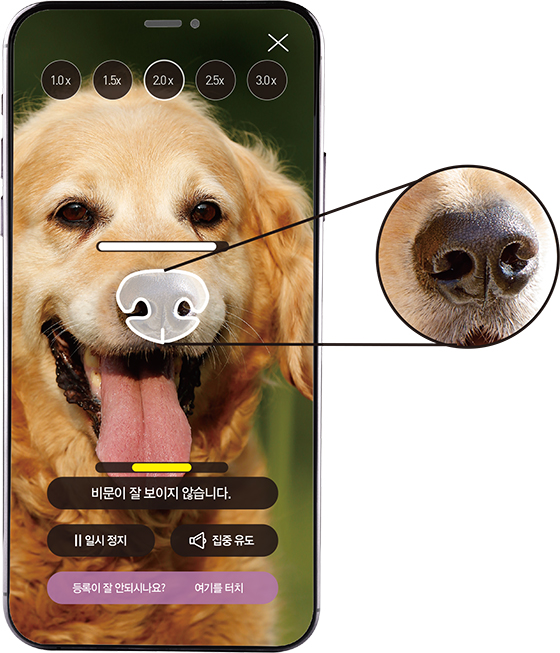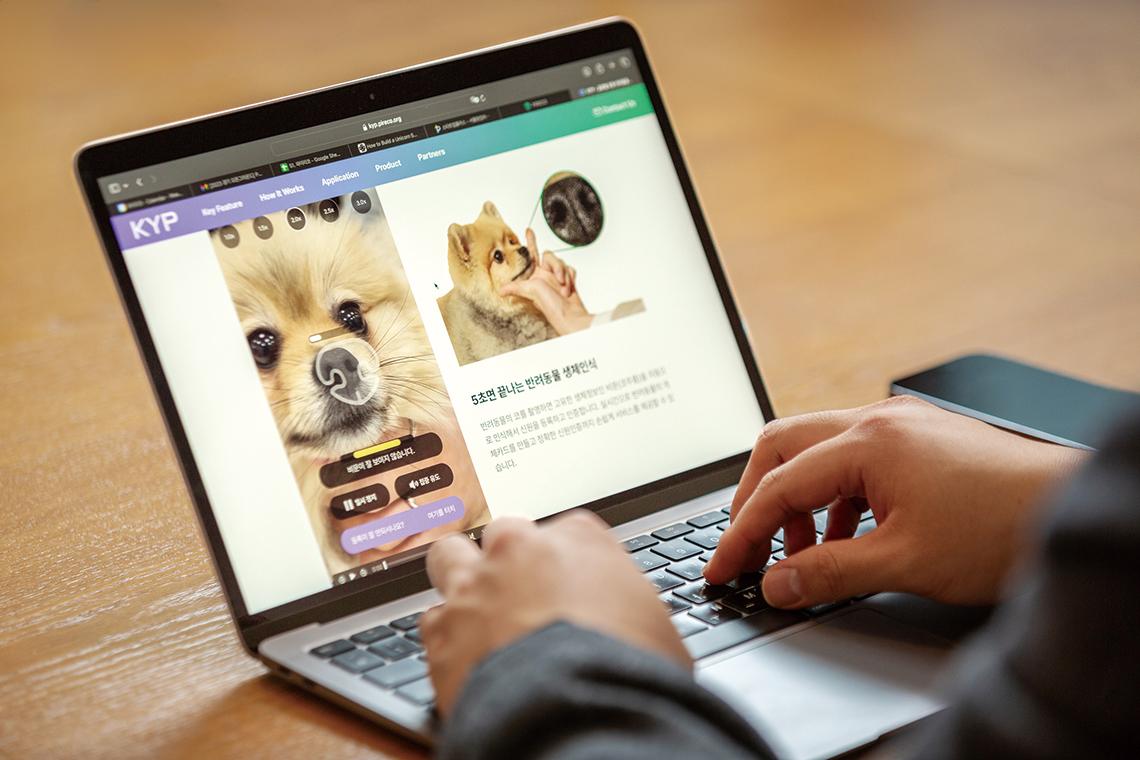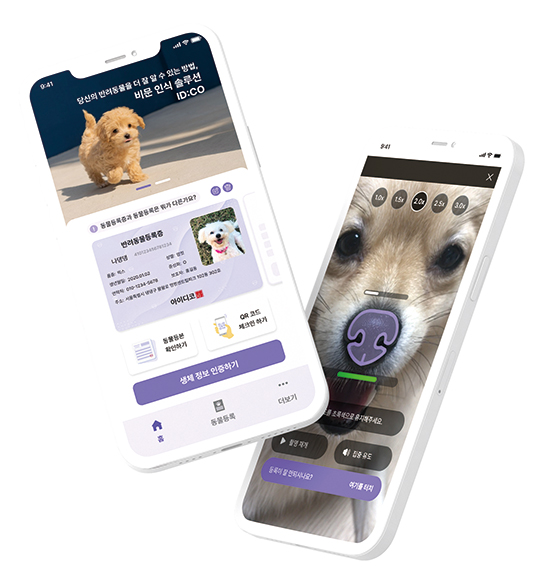
- Outside
- Setting new global standard
for identification of companion animals
본문영역
Setting new global standard
for identification of companion animals
Yang Yibin, CEO of PIRECO (Department of Management Science, Entered UNIST in 2013)
PIRECO, a pet tech startup that originated from UNIST, provides a mobile service using ‘multiple biometric-based pet individual identification technology standards’. Nowadays, with the pet population steadily increasing, this company has taken the lead in international standardization of this innovative technology that helps owners keep their pets safe, and prevents various problems that may arise during the adoption and fostering process.

Guarantees systematicity from birth to history management
“To put it simply, PIRECO provides mobile nose prints recognition technology that creates a ‘Dog ID.’ With this certification, you can check everything from information about the guardian, to disease and activity history. The core of our business is to understand pets well, and match them with the services they need at the right time.”
Just as people can check various information by looking up their resident registration number and share the necessary information with relevant organizations, the same goes for the Dog ID. Just as humans have unique fingerprints, so also do pet animals have distinctive nose prints, and individual identification is possible through this biometric information. PIRECO developed this nose print-recognition technology and commercialized it through a mobile application, and came up with an international standard proposal to incorporate the technology into the national animal registration system.
“The existing national animal registration system has registered pets with ‘built-in chips,’ by inserting chips under the skin, or as ‘external pendants’ in the form of necklaces. Many guardians are concerned about the side effects of the built-in chip, and the external pendant has reached its limits in activation due to the risk of loss.”
The most representative animal registration system implemented in most countries around the world is the built-in chip. However, since it involves inserting a foreign object into the body, there is a high risk of side effects. In the case of external pendants, there is no international standard as they are only used domestically. Therefore, since it is not compatible in other countries, there is the inconvenience of having to get a built-in chip inserted into the pet's body when preparing for overseas travel. Nose print recognition was thus invented while considering a safe and permanent method to solve these problems. Not only does it have no side effects or risk of loss, but it is also simple and accurate, making it safe both for pet animals and their guardians. It can also lower the risk of adoption fraud, which intentionally omits the pet animal's disease history. In particular, it is economical and highly effective because there are no restrictions on time and space, and automatic photographing can be done with a smartphone camera without a separate device.
The idea of biometric identification using a nose print came from Kim Tae-Heon, co-CEO of PIRECO. The advice of a veterinarian whom CEO Kim Tae-Heon met when he was leading the UNIST pet volunteer group was effective. Thanks to this, CEO Kim learned about the characteristics of nose prints that the general public is not familiar with, and also began to think about what would be a safe direction for identifying pet animals. Iris recognition, which we commonly use with smartphones, can also be used on dogs, but there is a high risk of developing diseases such as cataracts and glaucoma. For this reason, considering the permanence of inscription recognition, this is the optimal method.

- Pet animals biometric identification completed within five seconds!
- A pet animal’s nose has a nose print (nose wrinkle) that has unique biometric information, like a human fingerprint. By utilizing PIRECO's technology, you can simply automatically recognize the nose print, and register and verify your pet animal’s identity.

Background to adoption as an international standard
International standards are ‘recommendations’ and ‘guides’ that are applied worldwide to comply with when introducing a specific technology. Recognizing a technology as an international standard means that it has versatility and affects all countries around the world.
“Every semi-annual year, the Ministry of Science and ICT selects a national delegation to establish international standards for the International Telecommunication Union (ITU) under the UN. This national delegation attends an international conference held in Geneva, Switzerland. Dr. Kim Jae-seong of the Korea Internet & Security Agency (KISA), who has been working on international standards projects for decades, led PIRECO to participate in the relevant standards group.”
Dr. Kim Jae-seong and PIRECO jointly proposed an international standard using nose print recognition, and PIRECO's technical know-how was incorporated into the standard document without any additions or subtraction — achieving the world's best performance in being pre-adopted as a UN international standard technology. However, since the fact that a single company has created a global technical standard is tantamount to a monopoly, it is very important to collect opinions from stakeholders within the industry to establish standards. To this end, PIRECO specified the minimum requirements to be commonly applied through technical discussions with domestic nose print recognition companies. With PIRECO taking the lead, the requirements for domestic nose print and biometric recognition technology were standardized, thus making it possible to complete an international standard with significant impact. Adoption of a technology as an international standard not only means that the technology can be expanded and applied to all countries, but it also means that the governance of pet animals can be completely changed.
“We would like to contribute to the legislative process so that the legislative authorities of each country, including in our country, can discuss whether to introduce technology based on the relevant standards. Since inscription recognition has achieved international standards and is understood to be an animal-friendly method, we expect that most countries will be able to introduce this technology into their animal registration systems.”
CEO Yang Yibin predicted that once inscription recognition technology is legislated based on standards, the number of places using it will gradually expand, including animal hospitals, pet insurance, and pet animals platforms. It seems clear that this will be an irreplaceable technology for raising pet animals.
- ‘PIRECO’, a pet tech startup that started at UNIST, is changing the governance of pet animals with ‘multiple biometric-based pet animal identification technology standards’
-

PIRECO's mobile nose print recognition-based pet animal history management solution is drawing wide attention as the world's first technology of its kind.
Until the day we attain the forefront in pet animal data management
Started by UNIST and blossomed, PIRECO. CEO Yang Yibin, who studied at the Department of Management Science, is not actually a founding member. He joined the company in March 2022 at the suggestion of CEO Kim Tae-Heon, the founder of PIRECO. Until then, he was in charge of the expansion into the United States of UNIST's representative startup, ‘Class 101,’ and was responsible for pioneering the Korean market for ‘Speak Easy Labs,’ a promising Silicon Valley startup. CEO Yang Yibin traveled back and forth between the USA and Korea to coordinate the cultures of each country and build a business environment tailored to the market. As someone who is more passionate than anyone else about achieving scale-up, he is a management professional who was recruited by CEO Kim Tae-Heon, hoping that the third time would be a charm. CEO Yang Yibin was also fascinated by PIRECO's vision, so he did his best to support PIRECO's growth by supporting CEO Kim Tae-Heon's passion. He is currently continuing the growth of PIRECO in place of CEO Kim Tae-Heon, who is temporarily absent due to alternative military service.
“I believe that the biggest driving force that brought me to this position was that I always worked with a sense of ownership of ‘This is my company,’ no matter what position I held. I think the desire to ‘grow my company with like-minded people’ is what led me to join PIRECO.”
PIRECO took its first step by moving into UNIST UNISPARK in September 2018. In addition, the startup built technological capabilities through various projects such as preliminary startup package (formerly open voucher), initial startup package, Stepping Stone R&D, data voucher, TIPS program, IP R&D, and AI learning data construction project. As a result, they have attracted a cumulative investment of approximately 900 million KRW to date. They are drawing the world's attention with the world's first mobile nose print recognition-based pet animals history management solution, and are dreaming of bigger things. PIRECO is set to become the leader in pet animals history management using ‘Dog ID.’ With this, they would like to convey their ambition to change the adoption culture and raising behavior patterns for pet animals.
“I would like to welcome the day when it becomes common to use nose print recognition data to register at a veterinary hospital and present your dog's nose print recognition data when traveling abroad. If a company can bring about changes in people's behavior patterns, wouldn't it be possible to become a unicorn in the pet tech field?”

